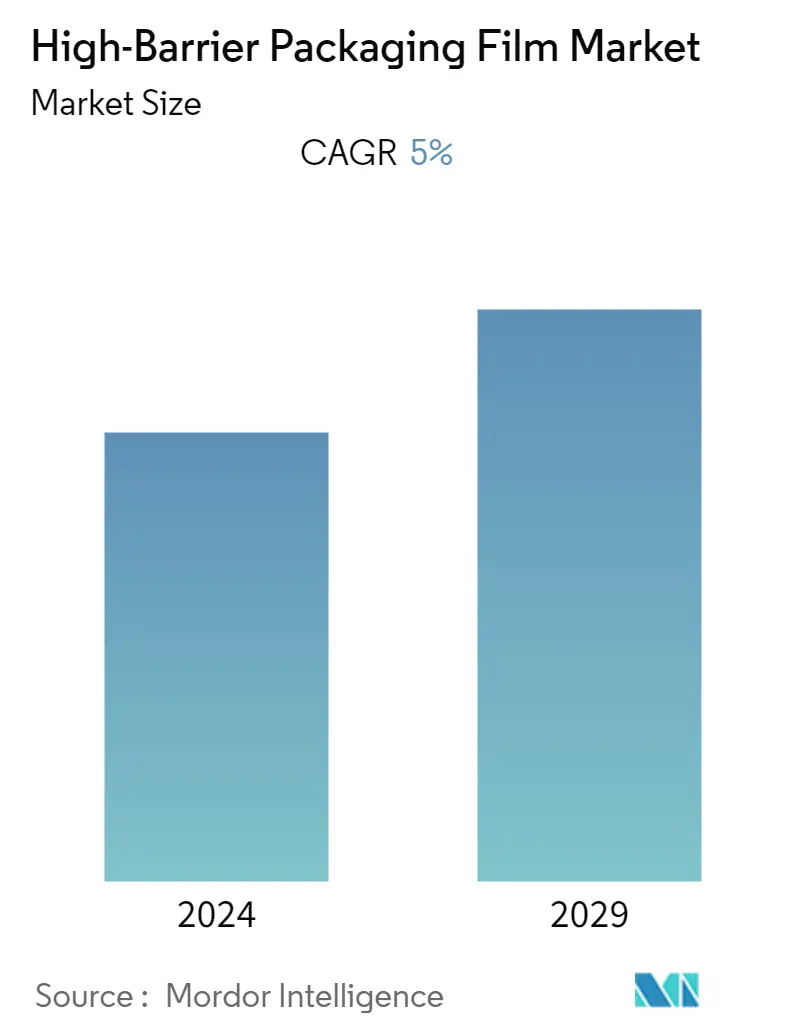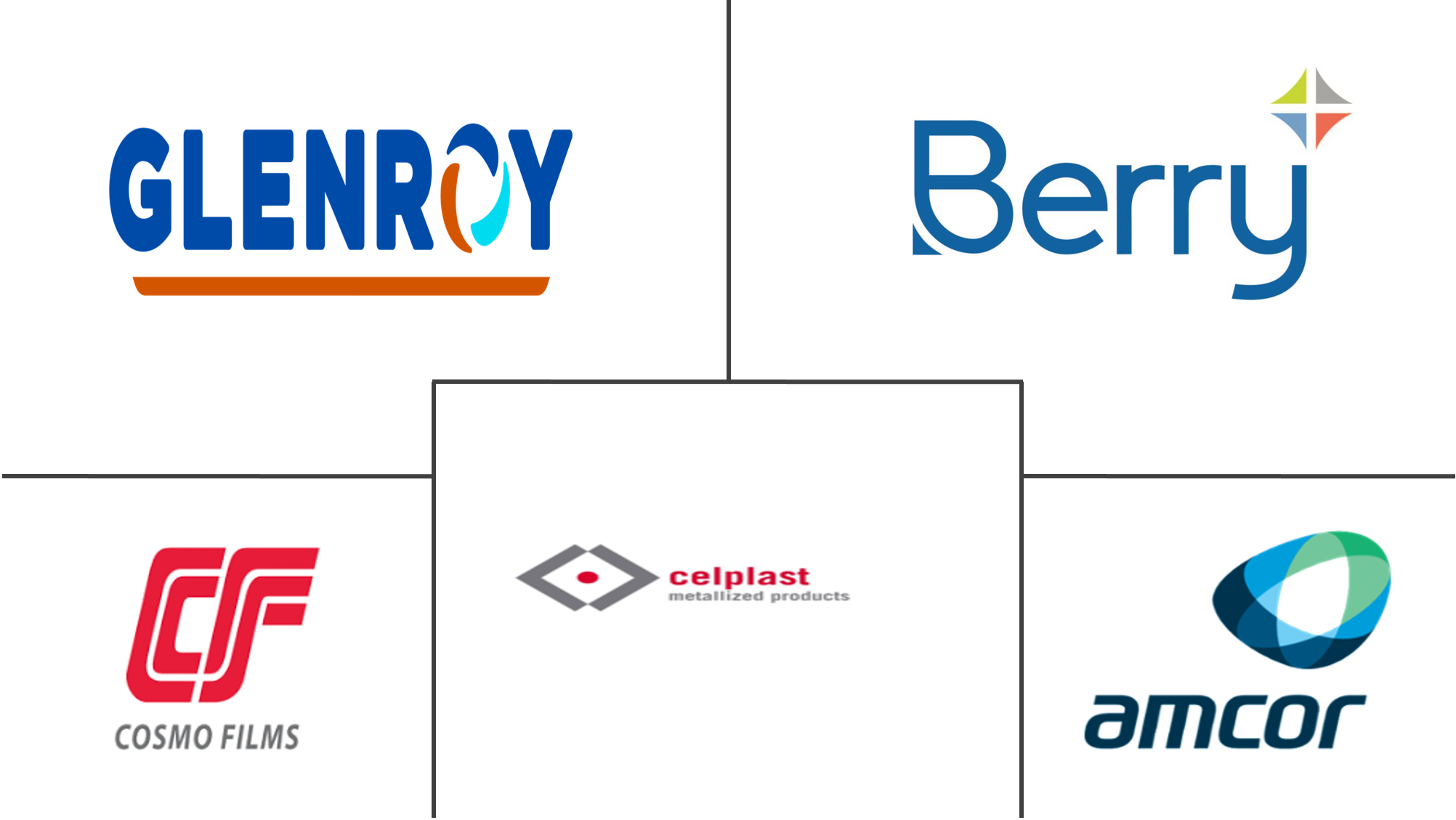Market Size of High-Barrier Packaging Film Industry

| Study Period | 2019 - 2029 |
| Base Year For Estimation | 2023 |
| CAGR | 5.00 % |
| Fastest Growing Market | Asia Pacific |
| Largest Market | North America |
| Market Concentration | Low |
Major Players
*Disclaimer: Major Players sorted in no particular order |
High Barrier Packaging Films Market Analysis
The market for high-barrier packaging film has seen a CAGR of 5% in the upcoming years. Growing urbanization has increased consumer demand for packaged foods. Additionally, goods and user safety concerns have grown to be essential variables, which are anticipated to cause the high-barrier packaging market to expand profitably over the projected year.
- The high-barrier packaging films help to keep oxygen, carbon dioxide, and moisture out while limiting the effects of mineral oil and UV light. This strong barrier, made of functional materials, also retains food qualities such as color, taste, texture, aroma, and flavor. Also, ready-to-eat foods are becoming more popular around the world, which makes people more likely to buy packaged products.
- According to the Food and Agriculture Organization, global meat consumption per capita in 2028 will be 35.1 kilograms, an increase from 34.4 kilograms in 2019. The increasing demand for meat globally propels polyethylene, a high-performing film. These films are ideal for fish, poultry, and meat packaging because they are an excellent oxygen barrier, durable, and heat resistant.
- Moreover, the pharmaceuticals sector poses different demands for packaging solutions regarding insulation from external surroundings, high levels of protection, cost-effectiveness, and ease of handling. Thus, blister base high packaging films are widely used because these films do not allow the exchange of gasses across the packaging and control the temperature within the package, thereby augmenting the market. However, volatile raw material prices and stringent government regulations in specific end-user industries limit the adoption of the high-barrier packaging film market.
- The outbreak is expected to necessitate flexible packaging across various countries. China has a very low consumption rate per capita of flexible packaging for fresh and processed meat and seafood compared to Japan, the United States, and Western Europe. However, the usage increased due to several advantages of flexible packaging solutions, such as live on-site butchering, improved sterilization, traceability, recall, and extended shelf life.
- Due to COVID-19, many Global Food Safety Initiative (GFSI) certification programs are giving six-month certificate extensions by doing a remote audit and risk assessment. This lets the company approve a new supplier location without having to do an on-site audit.
Moreover, with the increasing demand for medical and healthcare supplies, the high-barrier film packaging market is expected to witness significant growth in the future. For instance, Envy Pack is also continuing its operation by supplying medical and healthcare packaging solutions in clear pouches, pockets, and adhesive-backed sleeves, with and without print, to meet the demand.
High Barrier Packaging Films Industry Segmentation
High-barrier films are flexible films that restrict water, oxygen, light and other elements from entering or exiting a product's packaging. The study tracks the demand for the High-Barrier Packaging Film Market. Also, it depicts the global demand for high-barrier packaging film by its consumption through revenue. The high-barrier packaging film market reports give a detailed analysis of the different types of high-barrier packaging film products, materials, and their end-user industries. By region, the market has been segmented into North America, Europe, Asia-Pacific, the Middle East & Africa, and Latin America. This report also discusses key packaging film suppliers, key resin manufacturers, and critical end-user base manufacturer profiles. The market sizes and forecasts are provided regarding value (in USD billions) for all the above segments.
| By Packaging Product | |
| Bags & Pouches | |
| Stretch & Shrink Wrap Film | |
| Tray Lidding Film | |
| Stand-up Pouches | |
| Thermoforming Films | |
| Blister base Film |
| By Material | |
| Polyethylene | |
| BOPET | |
| Polypropylene | |
| Polyvinyl Chloride |
| By End-user Industry | |
| Food & Pet Food | |
| Beverages | |
| Pharmaceutical & Medical | |
| Agriculture | |
| Other End-users |
| Geography | ||||||||
| ||||||||
| ||||||||
| ||||||||
| ||||||||
|
High-Barrier Packaging Film Market Size Summary
The high-barrier packaging films market is poised for significant growth, driven by increasing urbanization and the rising demand for packaged foods. These films are essential for preserving the quality of food products by blocking out oxygen, carbon dioxide, moisture, and UV light, thereby maintaining color, taste, texture, aroma, and flavor. The growing popularity of ready-to-eat foods and the rising global meat consumption further propel the demand for these films, particularly in the packaging of fish, poultry, and meat due to their excellent barrier properties. The pharmaceutical sector also contributes to market expansion, as high-barrier films provide necessary insulation and protection for medical products. However, challenges such as volatile raw material prices and stringent regulations in certain industries may hinder market growth.
The Asia-Pacific region is expected to experience the fastest growth in the high-barrier packaging films market, fueled by increasing consumerism and rising purchasing power in countries like India and China. The region's expanding pharmaceutical industry and the demand for packaged foods and beverages are key factors driving this growth. The market is characterized by intense competition among global players like Amcor Plc, Glenroy, Inc., and Berry Global Group Inc., who are investing heavily in research and development to meet environmental and regulatory standards. Recent innovations, such as Toppan's mono-material PE barrier, highlight the industry's focus on developing sustainable and efficient packaging solutions to cater to the growing demand in European and North American markets.
High-Barrier Packaging Film Market Size - Table of Contents
-
1. MARKET DYNAMICS
-
1.1 Market Overview
-
1.2 Introduction to Market Drivers and Restraints
-
1.3 Market Drivers
-
1.3.1 Pharmaceuticals Sector is Expected to Register a Significant Growth
-
1.3.2 Growing Demand for High-Barrier Packaging Film across the Globe
-
-
1.4 Market Restraints
-
1.4.1 Fluctuated Raw Material Prices
-
-
1.5 Industry Value Chain Analysis
-
1.6 Industry Attractiveness - Porter's Five Force Analysis
-
1.6.1 Threat of New Entrants
-
1.6.2 Bargaining Power of Buyers/Consumers
-
1.6.3 Bargaining Power of Suppliers
-
1.6.4 Threat of Substitute Products
-
1.6.5 Intensity of Competitive Rivalry
-
-
-
2. MARKET SEGMENTATION
-
2.1 By Packaging Product
-
2.1.1 Bags & Pouches
-
2.1.2 Stretch & Shrink Wrap Film
-
2.1.3 Tray Lidding Film
-
2.1.4 Stand-up Pouches
-
2.1.5 Thermoforming Films
-
2.1.6 Blister base Film
-
-
2.2 By Material
-
2.2.1 Polyethylene
-
2.2.2 BOPET
-
2.2.3 Polypropylene
-
2.2.4 Polyvinyl Chloride
-
-
2.3 By End-user Industry
-
2.3.1 Food & Pet Food
-
2.3.2 Beverages
-
2.3.3 Pharmaceutical & Medical
-
2.3.4 Agriculture
-
2.3.5 Other End-users
-
-
2.4 Geography
-
2.4.1 North America
-
2.4.1.1 United States
-
2.4.1.2 Canada
-
-
2.4.2 Europe
-
2.4.2.1 United Kingdom
-
2.4.2.2 France
-
2.4.2.3 Germany
-
2.4.2.4 Italy
-
2.4.2.5 Spain
-
2.4.2.6 Rest of Europe
-
-
2.4.3 Asia-Pacific
-
2.4.3.1 China
-
2.4.3.2 Japan
-
2.4.3.3 India
-
2.4.3.4 Rest of Asia-Pacific
-
-
2.4.4 Latin America
-
2.4.4.1 Mexico
-
2.4.4.2 Brazil
-
2.4.4.3 Rest of Latin America
-
-
2.4.5 Middle-East and Africa
-
2.4.5.1 Turkey
-
2.4.5.2 Rest of Middle-East & Africa
-
-
-
High-Barrier Packaging Film Market Size FAQs
What is the current High-Barrier Packaging Film Market size?
The High-Barrier Packaging Film Market is projected to register a CAGR of 5% during the forecast period (2024-2029)
Who are the key players in High-Barrier Packaging Film Market?
Amcor plc, Berry Global, Inc, Cosmo Films Limited, Celplast Metallized Products Limited and Glenroy, Inc. are the major companies operating in the High-Barrier Packaging Film Market.

